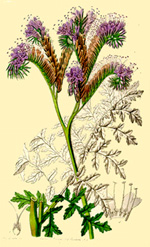 |
This small family occurs widely in North and South America, sub-Saharan Africa, east Asia and from India to northern Australia. Two native species occur on Cape York Peninsula, while a few introduced species are minor weeds of disturbed places across southern Australia.
Characteristic features of the family Hydrophyllaceae in Australia include: - annual or perennial herbs or small shrubs, with alternate, often glandular-hairy, simple or compound leaves
- flowers often showy, purple or blue, actinomorphic, with 5 free sepals and 5 petals fused into a funnel-shaped or wheel-shaped tube
- stamens 5, inserted at the base of the corolla-tube often with a pair of small scales at the base of the filaments
- ovary superior, developing into a 2-valved capsule
Description
Evergreen shrubs, or annual, biennial or perennial terrestrial herbs. Perennating by rhizomes. Vegetative reproduction by rhizomes or stolons. Stem internodes terete or distinctly angular. Internal secretions not obvious. Plants glabrous, or with glandular or non-glandular, uniseriate hairs. Leaves alternate and spiral, cauline or both basal and cauline if herbs, petiolate or subsessile. Stipules absent. Lamina simple or once compound, imparipinnate, symmetric, pinnatifid or pinnatisect; lamina/leaflets filiform, acicular, subulate, linear, lanceolate, ovate, elliptic or oblong; base cuneate or attenuate; margins entire or dentate or serrate, ±flat; venation pinnate, with the midrib conspicuous, and the tertiary venation not reticulate; surfaces not punctate; herbaceous; distinctive odour absent or foetid. All the flowers bisexual. Inflorescences terminal or axillary, consisting of monochasial cymes or solitary flowers. Bracts present. Bracteoles present or absent. Pollination by insects. Flowers stalked. Floral disc absent; nectaries absent. Perianth regular, of 2 dissimilar whorls, imbricate in bud. Epicalyx present or absent. Calyx segments free or fused, with 5 sepals or lobes; calyx bell-shaped or urn-shaped, herbaceous. Corolla segments fused, with 5 lobes, alternating with the sepals or calyx lobes; corolla wheel-shaped, bell-shaped or funnel-shaped, white, magenta, purple or blue, without contrasting markings, or streaked, spotted, etc, membranous; lobes ±entire. Fertile stamens 5, opposite to the sepals or calyx lobes, at least partly fused to the corolla, free of the ovary and style, distinct from each other, all ±equal. Anthers dorsifixed, versatile, opening inwards by longitudinal slits; 2-celled. Ovary superior and sessile. Carpels 2, fused; ovary with 1 locule. Style terminal, single and unbranched, or branched above or from the base. Ovules 2–numerous, stalked or sessile; placentation parietal. Fruit a dry, dehiscent capsule with irregular or loculicidal dehiscence; the perianth on the maturing fruit deciduous or dry and persistent. Disseminule macro-surface costate; micro-surface ±colliculate, orange or brown, glossy or dull. Seeds 2–numerous per fruit. Cotyledons 2. Embryo straight.
(Note: this description has been generated from the coded data compiled for the key. Any errors in the key data will be reflected in the descriptions.)
A treatment of the family Hydrophyllaceae has not yet been published in the Flora of Australia. It will appear in Volume 30.
Australian genera of Hydrophyllaceae (as recognised for the Flora of Australia)
* = all species introduced
Hydrolea
*Phacelia

|
  |

Phacelia tanacetifolia
©
|

| |